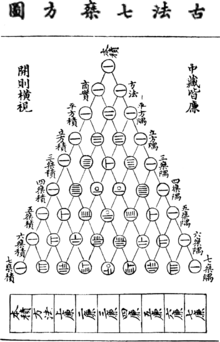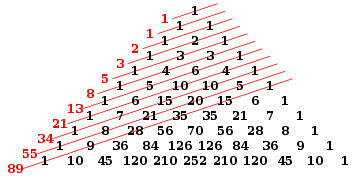Pascal's triangle
Pascal's (or Pascal's) triangle is a form of graphical representation of binomial coefficients 
can be described. The variable 




The name goes back to Blaise Pascal. However, Pascal's triangle was known earlier and is therefore still named after other mathematicians. In China one speaks of the Yang-Hui triangle (after Yang Hui), in Italy of the Tartaglia triangle (after Nicolo Tartaglia) and in Iran of the Chayyām triangle (after Omar Chayyām).

Each entry is the sum of the two entries above it.
History
The earliest detailed account of a triangle of binomial coefficients appeared in the 10th century in commentaries on the Chandas Shastra, an Indian book on Sanskrit prosody written by Pingala between the fifth and second centuries BCE. While Pingala's work survives only in fragments, the commentator Halayudha used the triangle around 975 to establish dubious relationships with Meru-prastaara the "steps of Mount Meru." It was also already known that the sum of the flat diagonals of the triangle gives the Fibonacci numbers. From the Indian mathematician Bhattotpala (approx. 1070) the first 17 lines of the triangle are handed down.
At about the same time, Pascal's triangle was treated in the Middle East by al-Karaji (953-1029), as-Samaw'al, and Omar Chayyām, and is therefore known in modern Iran as the Chayyām triangle. Various mathematical theorems concerning the triangle were known, including the binomial theorem. In fact, it is fairly certain that Chayyām used a method to calculate the 
The earliest Chinese representation of an arithmetic triangle identical to Pascal's triangle is found in Yang Hui's book Xiangjie Jiuzhang Suanfa of 1261, excerpts of which are preserved in the Yongle Encyclopedia. In it, Yang writes of having adopted the triangle from Jia Xian (c. 1050) and his method of calculating square and cube roots called li cheng shi shuo ("determining coefficients by means of diagram").
Peter Apian published the triangle in 1531/32 on the cover of his book on trade calculations, whose earlier version of 1527 is the first written record of Pascal's triangle in Europe.
In 1655, Blaise Pascal wrote the book "Traité du triangle arithmétique" (Treatise on the arithmetic triangle), in which he collected various results concerning the triangle and used them to solve problems in probability theory. The triangle was later named after Pascal by Pierre Rémond de Montmort (1708) and Abraham de Moivre (1730).

Yang-Hui triangle as described in a book written by Zhu Shijie in 1303.

Blaise Pascal's version of the right triangle
Application
Pascal's triangle gives a handle to quickly multiply out arbitrary powers of binomials. For example, the second line ( 
In the next, the third line, we find the coefficients 1, 3, 3, 1 for 
This list can be continued arbitrarily, whereby it is to be noted that for the binomial 



Furthermore, when Pascal's triangle is applied to the binomial 

A two-dimensional generalization is the Trinomial Triangle, in which each number is the sum of three (instead of two in Pascal's Triangle) entries. An extension into the third dimension is the Pascal's Pyramid.
Sequences in Pascal's triangle
In Pascal's triangle many well-known number sequences can be found.
The diagonals
The first diagonal contains only ones and the second diagonal contains the sequence of natural numbers. The third diagonal contains the triangular numbers and the fourth diagonal contains the tetrahedral numbers. In general, in the 

In general, the following applies to the triangular numbers

for the tetrahedral numbers
and for the regular figured numbers of order

The Fibonacci numbers
|
|
|
|
|
|
|
|
|
|
| |
|
|
|
|
|
|
|
|
|
|
|
|
|
|
|
|
|
|
|
| |
| |
|
|
|
|
|
|
|
|
|
|
|
|
|
|
|
|
|
| |
| |
| |
|
|
|
|
|
|
|
|
|
|
|
|
|
|
|
| |
| |
| |
| |
|
|
|
|
|
|
|
|
|
|
|
|
|
| |
| |
| |
| |
| |
|
|
|
|
|
|
|
|
|
|
|
| |
| |
| |
| |
| |
| |
|
|
|
|
|
|
|
|
|
| |
| |
| |
| |
| |
| |
| |
|
|
|
|
|
|
|
| |
| |
| |
| |
| |
| |
| |
| |
|
|
|
|
|
| |
| |
| |
| |
| |
| |
| |
| |
| |
|
|
|
| |
| |
| |
| |
| |
| |
| |
| |
| |
| |
|
| |
| |
| |
| |
| |
| |
| |
| |
| |
| |
| |
The sums of the flat "diagonals" marked here in green, red and blue each give a Fibonacci number (1, 1, 2, 3, 5, 8, 13, 21, 34, ...). In this example, the sum of the green diagonal is equal to 13, the sum of the red diagonal is equal to 21, the sum of the blue diagonal is equal to 34. The fact that sometimes the "diagonal" cannot be "pulled through" from one end to the other, as in the case of the red diagonal, is irrelevant.
In general
The lines
The sum of the entries in a row is called the row total. From top to bottom, the row sums double from row to row. This comes from the formation law of the Pascal triangle. Each entry of a line is used in the following line to calculate two entries. Here, one must generalize the formation law by adding imaginary zeros to the left and right of each line, so that the outer ones of each line are also generated by adding the entries above it. Since the row sum of the first row is equal to one, the row sum of the 

If you line up the digits of the first five lines of the Pascal triangle, you get 1, 11, 121, 1331 and 14641, which are the first powers of 11.
The alternating sum of each line is zero: 
Formally, the three formulas above follow from the binomial theorem 



Mean binomial coefficients
The sequence of mean binomial coefficients starts with 1, 2, 6, 20, 70, 252, ... (sequence A000984 in OEIS).

Alternative representation: The Fibonacci numbers as the sum of the diagonals (red lines).
Connection with the Sierpinski triangle
Pascal's triangle is related to Sierpinski's triangle, named in 1915 after the Polish mathematician Wacław Sierpiński. Both triangles use a simple but slightly different iteration rule that produces a geometric similarity.
Powers with arbitrary base
For powers with arbitrary base there exists a number triangle of a different kind:
This triangular matrix is arrived at by inversion of the matrix of coefficients of those terms representing the combinations without repetition of the form 
Example

Reading
Example
The formation law of the coefficients for the coefficient in row 

therefore 

With the help of this triangle one gains immediate insight into the divisibility of powers. Thus, any prime power 









With this number triangle, for example, it can be easily proved that 



is always divisible by 24, since because of 

Connection with the Wallis product
In 1655, John Wallis used a checkerboard interpolation between the number sequences figured (per dimension) to compute for the first time a representation of 4/
Other
About the numbers with which a number occurs in Pascal's triangle there is the Singmaster conjecture.
See also
- Binomial theorem
- Harmonic triangle
Search within the encyclopedia













































![E(i,j) = [ E(i-1,j-1) + E(i-1,j) ]\cdot j](https://www.alegsaonline.com/image/4b9cad5210a10bdfd206c20db903ebdc3ac721ae.svg)